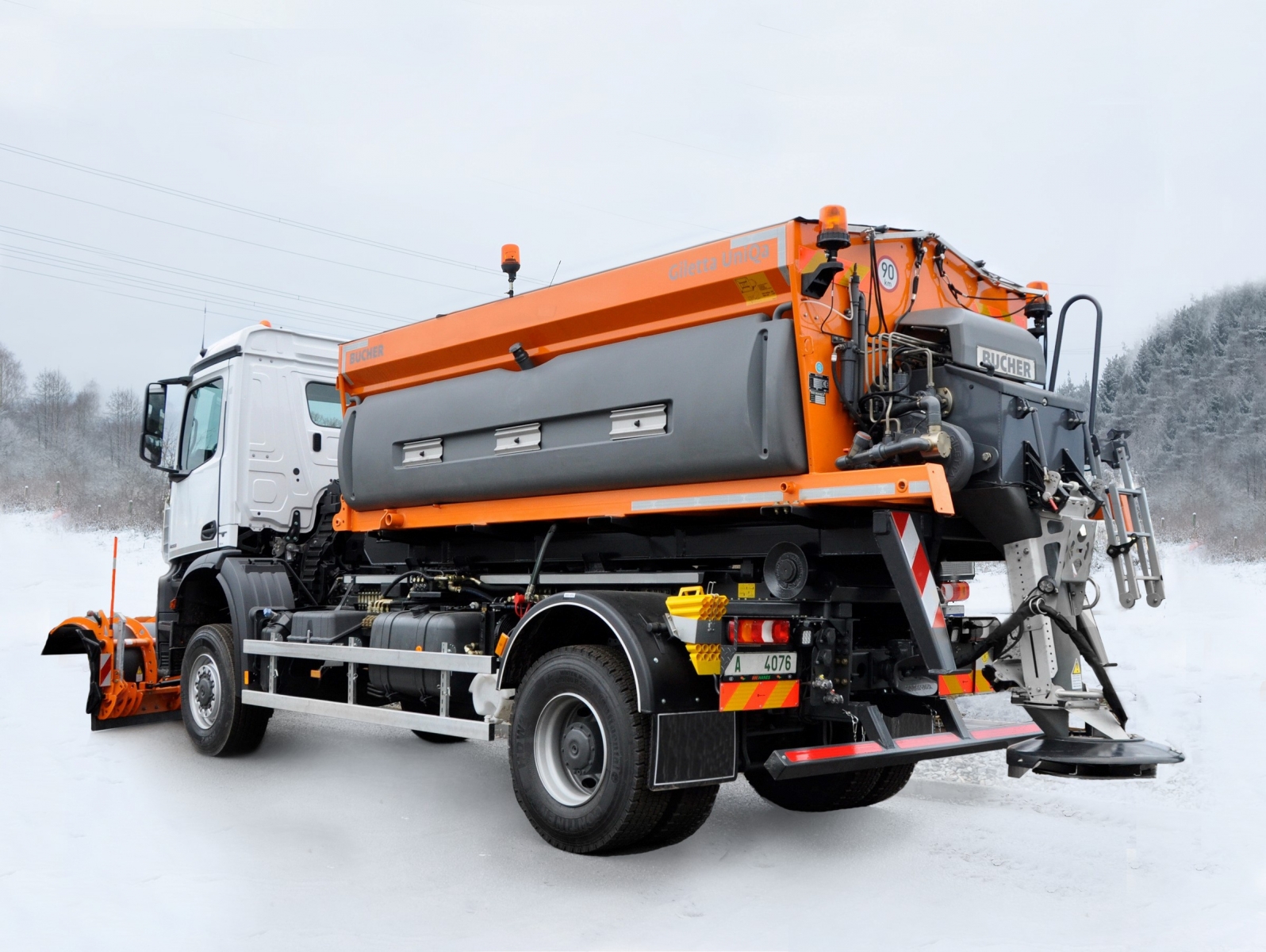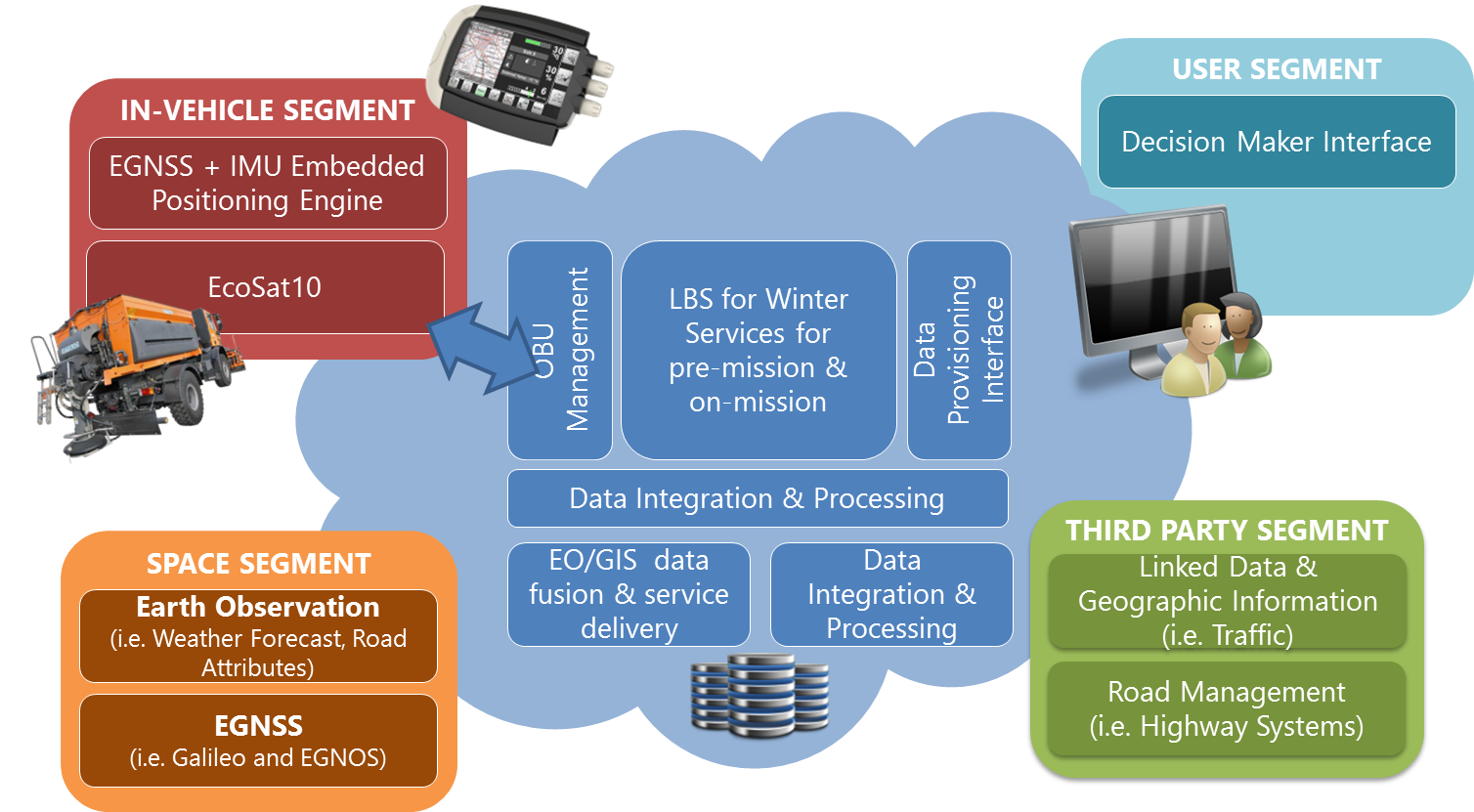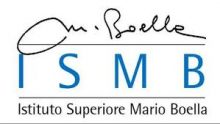
Objectives of the service
Considering the winter road maintenance domain (a quite huge market estimated to be about 75 M€ in Europe), there is a high potential for space-based high-end services in supporting the winter maintenance activities, mostly clearing snow from roads and anti-/de-icing by spreading chemicals (e.g. salt) on the road surface. The most promising opportunities appear to come from the capability (ensured by cost-effective satellite navigation technologies and high-resolution Earth Observation imagery) to provide a full – possibly automatic - control of the winter maintenance equipment along the mission, then optimizing the operations and reducing manual intervention of the operator while driving the vehicle. Exploiting the insights from the forerunner feasibility study, the ASSIST WRM demonstration project validates a set of advanced “assistance services” in a pre-operational status during the complete 2016-2017 winter season, involving relevant users and stakeholders over four different representative “pilot areas” in different European countries, namely the countryside of Goteborg (Sweden), a motorway around the city of Wien (Austria), an highway leading to an Alpine pass in Italy and a mountain region in Norway. As a result of ASSIST WRM, profitable and self-sustaining products and services are expected to be fully operational and ready for the market by 2017-2018 winter season.

Users and their needs
Considering Europe as the key market for ASSIST WRM solutions, three primary groups of target users can be identified:
- public administrations, responsible for the maintenance (throughout the year) of national or local public roads;
- private/public contractors for the public administrations outsourcing maintenance services;
- private/public concessionaires, responsible for the operation and maintenance of toll roads according to a long-term concession contract with public administrations.
The four users (from Italy, Austria, Norway and Sweden) supporting the ASSIST WRM pilot-demonstration represent precisely the different groups above and all together allow to address around a third of the overall potential market at European level.
Being the winter road maintenance a challenging task (and also a growing concern and cost for the public authorities), all the users above share the need of:
- an optimization of the maintenance activities, leading to an improved effectiveness of the treatment (with respect to “service level agreements”), while reducing the costs and the impact on the environment;
- a reduction of the workload for the operators driving the vehicles, in order to make more comfortable her/his task while reducing the probability of unwanted and/or dangerous results;
- a better information to the operator about the operational context to ensure his/her safety and that of other road users, while ensuring the best possible winter maintenance operations’ results.
The possibility to exploit the integration of information as weather forecast, road attributes and the exact position of the vehicle (thanks to satellite navigation technologies) – as addressed by ASSIST WRM - appear to be the keys to meet the user needs.
Service/ system concept
Developing cost-effective solutions based on satellite navigation technologies and exploiting the very high resolution imagery from Earth Observation, ASSIST WRM intends to provide a suite of advanced “assistance services” intercepting the needs of users in winter road maintenance domain. These services are delivered both to the operators/drivers and to the management by deploying a distributed service oriented architecture whose key elements are:
- an in-vehicle segment for managing the equipment (i.e. salt spreader, snow ploughs) and interfacing with the driver by means of a control box. This component includes a cost-effective embedded platform providing in real-time the precise and robust positioning of the vehicle as requested for a full control of the equipment, then bringing a real innovation in the winter maintenance domain;
- a back-office segment (build on top of cloud computing resources) playing a central role to aggregate all the information and create the added value services.

Space Added Value
Within the ASSIST WRM, two space assets play a pivotal role:
- Satellite navigation to allow the precise and robust positioning of the vehicles involved in the winter maintenance operation as requested for a full (possibly automatic) control of their equipment, by implementing a novel tightly-coupled integration between small-scale, cost-effective devices, such as
- multi-constellation GNSS (Global Navigation Satellite System) receiver i.e., GPS, Galileo and GLONASS (then providing better satellite visibility and worldwide coverage);
- low cost IMU (Inertial Measurement Unit) to make GNSS more reliable and precise;
- Earth Observation to get an up-to-date and accurate roads network spatial database, by employing very high resolution (VHR) satellite imagery for extracting relevant road attributes, including boundaries, centreline, width and sealed surfaces (e.g. parking lots, bus stops). Moreover, by exploiting GIS (Geographical Information System), the roads database from EO is enriched with additional data e.g. road slope.
Furthermore, the satellite communication is also foreseen as an optional feature to connect the mobile vehicles in case of poor coverage of cellular services.
Current Status
Kicked-off in December 2015, the ASSIST WRM demonstration project has been concluded in November 2017 by finalizing the planned roll-out stage following the pilot-demonstration that took place in the 2016-2017 winter season actively involving relevant users in four different European countries, i.e. Italy, Austria, Norway and Sweden.
Despite of a great effort of the Consortium as well as the collaboration of the engaged users, a very “bad” winter season (poor snowfall, quite mild climate) seriously hindered the regular execution of the intended activities, resulting in valuable overall figures (more than 6.000 km traveled by ASSIST WRM vehicles in real operations, more than 140 tons of material spreaded) but limited with respect to expectations. However, the ASSIST WRM value proposition is confirmed as a real revolution in winter maintenance but asking for change of mindset in managing the current operations.
Aiming to face with such evidence as well as with the limited pilot results, a specific follow-up plan has been identified, mostly led by Giletta S.p.A. Bucher Municipal organization (but supported by ad-hoc partnership agreements with other ASSIST WRM partners). Communication, awareness raising towards public contracting authorities and continuing on-field tests (securing the support of “early adopters”) are the major actions of such 3-year strategy. At the same time, a step-by-step commercial strategy is implementing a gradual approach towards the most advanced service levels by offering commercial packs designed to be as much flexible as possible to intercept specific customer’s needs.







